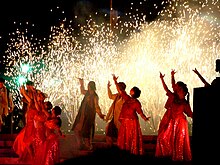Dance and song sequences have been an integral component of films across the country. With the introduction of sound to cinema in the film Alam Ara in 1931, choreographed dance sequences became ubiquitous in Hindi and other Indian films.[30]
Dance in early Hindi films was primarily modelled on classical Indian dance styles and particularly those of historic North Indian courtesans(tawaif), or folk dancers. Modern films often blend this earlier style with Western dance styles (MTV or in Broadway musicals), though it is not unusual to see western choreography and adapted classical dance numbers side by side in the same film. Typically, the hero or heroine performs with a troupe of supporting dancers. Many song-and-dance routines in Indian films feature dramatic shifts of location and/or changes of costume between verses of a song. It is popular for a hero and heroine to dance and sing a pas de deux (a Frenchballet term, meaning "dance of two") in beautiful natural surroundings or architecturally grand settings, referred to as a "picturisation".[31]Indian films have often used what are now called "item numbers" where a glamorous female figure performs a cameo. The choreography for such item numbers varies depending on the film's genre and situation. The film actress and dancer Helen was famous for her cabaret numbers.[32] The influence of the dance sequences of films on popular culture is significant, with amateur dancers often copying such dancing moves during celebratory events and performances, such as during wedding parties or other urbanized festivals.[citation needed]
Often in movies, the actors don't sing the songs themselves that they dance too, but have another artist sing in the background. For an actor to sing in the song is unlikely but not rare. The dances in Bollywood can range from slow dancing, to a more upbeat hip hop style dance. The dancing itself is a fusion of all dance forms. It could be Indian classical, Indian folk dance, belly dancing, jazz, hip hop and everything else you can imagine.[33]
Often in movies, the actors don't sing the songs themselves that they dance too, but have another artist sing in the background. For an actor to sing in the song is unlikely but not rare. The dances in Bollywood can range from slow dancing, to a more upbeat hip hop style dance. The dancing itself is a fusion of all dance forms. It could be Indian classical, Indian folk dance, belly dancing, jazz, hip hop and everything else you can imagine.[33]
Dance education[edit]
Traditionally, dance as a profession or a hobby was discouraged among upper classes and higher castes in India. It was looked upon as a lowly activity and women from reputed households were prohibited from practising any dance form. Hence, in forms like Bhavai[34] and Gotipua, men would take up the roles of female characters.[35]
Rukmini Devi Arundale revived the classical dance form Bharata Natyam and in its modern avatar, it became an acceptable subject of training for women.[36] Shiamak Davar, a noted Indian choreographer, started the Shiamak Davar Institute for Performing Arts in 1985 and it has over 25,000 members.[37]
Geographic spread[edit]
Some traditions of the Indian classical dance are practiced in the whole Indian subcontinent, including Pakistan and Bangladesh, with which India shares several other cultural traits. Indian mythologies play significant part in dance forms of countries in South East Asia, an example being the performances based on Ramayana in Javanese dances.[38]


No comments:
Post a Comment